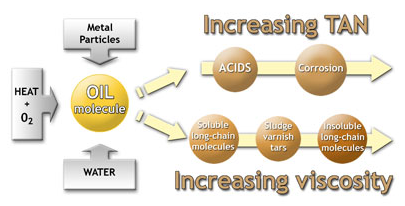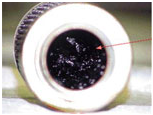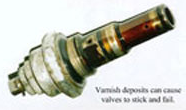Triple R America Group
Sludge

There are numberous types of insoluble contaminants found in hydraulic and lubricating systems. Insoluble contaminants are those materials that will not dissolve in the oil.

The two most general classifications of insoluble contaminants are hard contaminants, such as dirt, debris and wear particles, and soft contaminants, composed of the various oil degradation by-products.
Varnish and sludge originate from the soft contaminants. It is a thin, insoluble film that over time deposits throughout the internal surfaces of a lubrication system. The degradation process accelerates as the lubricant undergoes continued exposure to air, water, catalyst (metal particles) and high temperatures
Sludge contamination is, without doubt, the least recognized as far as hydraulic equipment contamination is concerned. Fact is that sludge is present in virtually every type of hydraulic and lubricating system . Given the fact that sludge is a "soft pollutant", it is not measured during possible oil analyses. Most operators are not aware of its presence in the oil.

Sludge presence can have far-reaching consequences :

Increased wear rates
Varnish captures hard contaminants, creating an abrasive surface that accelerates wear.

Heat exchangers become less efficient
Sludge deposit adhere to the inside of pipework, thus forming an insulating layer decreasing the cooling effect of heat exchangers.
This reduces the efficiency of the heat exchange and results in higher operating temperatures.
Again this leads to increased power consumption and to faster oxidation of the oil.

The main line filters get blocked:

Sludge is sticky, resinous substance, and it therefore stays behind in the pores of filters, quickly blocking them.
This may lead to decrease in the flow rate and/or a higher P, and as a result the drive will operate more slowly.
It becomes increasingly difficult for the pump to circulate the oil, leading to cavitation, higher power consumption and increased wear and tear.
The main line filters need to be replaced more frequently.

The main line filters get blocked:
Sludge is sticky, resinous substance, and it therefore stays behind in the pores of filters, quickly blocking them.
This may lead to decrease in the flow rate and/or a higher P, and as a result the drive will operate more slowly.
It becomes increasingly difficult for the pump to circulate the oil, leading to cavitation, higher power consumption and increased wear and tear.
The main line filters need to be replaced more frequently.


Valves clog or operate badly:
The presence of resins increases friction to 5-6 times higher than nominal value.
This will result in higher energy requirements and can cause stuck or seized valves.

Reduced clearance zones affecting lubrication
Often, this means a transition from full film to boundary lubrication, resulting in increased wear in pumps, bearings, gears and valves.

Increased wear rates
Varnish captures hard contaminants, creating an abrasive surface that accelerates wear.

System corrosion and accelerated degradation due to acidic constituents.

Increased maintenance
Resources and costs required to clean varnished systems.
Source: http://www.triple-rrr.com/technology/sludge.html